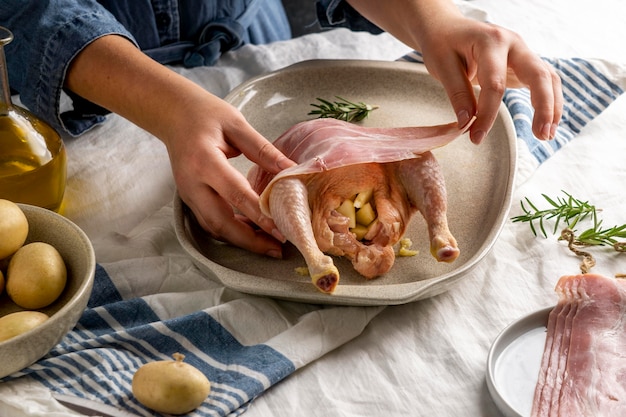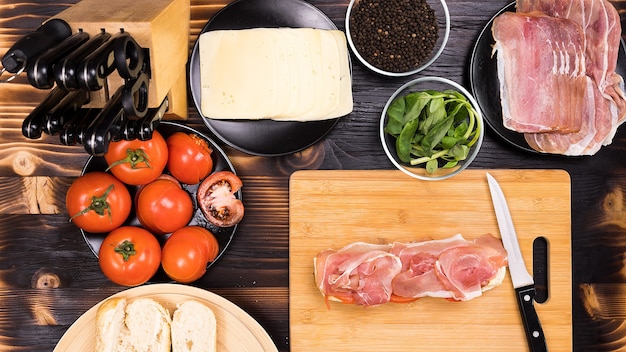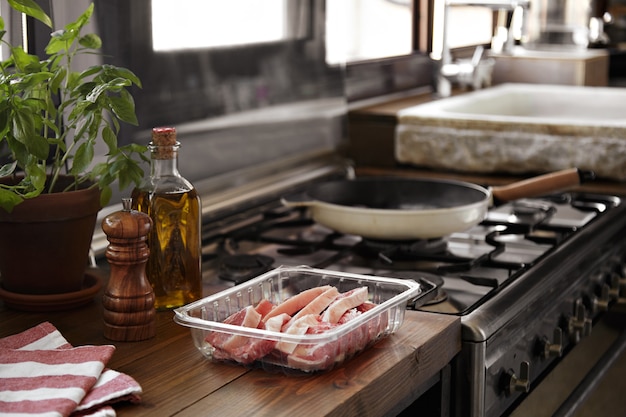A 9lb ham is a majestic centerpiece, a culinary triumph that screams “celebration!” But the sheer size of the beast can be daunting. Fear not, dear reader, for I’m here to guide you through the process, from selecting the perfect ham to achieving that glistening glaze and carving it with confidence. Buckle up, grab a cuppa, and let’s delve into the world of ham mastery together.
Part 1: Choosing the Right Ham

Picking the right ham is crucial, like choosing the right actor for the lead role. It’s the foundation of your hammy masterpiece.
Navigating the Ham Types
The ham world is full of different characters. The most common you’ll encounter are:
- spiral-sliced ham: This pre-cooked, bone-in ham is already sliced into a beautiful spiral, making it incredibly convenient. Just pop it in the oven for a quick reheat and you're good to go. Think of it as the "easy-going" ham, perfect for those who prefer convenience without compromising on flavour.
- Bone-in ham: This raw ham, usually sporting a shank and a foot, demands more attention and time. It requires a longer cook, but delivers a classic ham experience. This is the "dramatic" ham, ideal for those who want the full traditional experience.
- boneless ham: Pre-cooked and boneless, this ham is all about ease of carving and slicing. It’s a great option for a crowd, as it’s easier to portion and serve. This is the "practical" ham, best for those who prioritize practicality without sacrificing flavour.
For a 9lb ham, I’d lean towards a spiral-sliced or a bone-in ham. The spiral-sliced is a friend to busy cooks, while bone-in offers a more traditional, deeply satisfying experience. Think about the kind of experience you're looking for!
A Spectrum of Ham Flavours
Hams often come with a flavour profile that speaks to the soul. They're typically cured and smoked, creating a unique, mouthwatering aroma and taste. Here's a peek at the flavour spectrum:
- Honey-glazed: This classic combination of sweet and tangy is a sure-fire crowd-pleaser, bringing a touch of warmth and comfort to the table.
- Maple-glazed: A touch of sophistication, the rich buttery flavour of maple syrup adds a luxurious touch to any occasion.
- Brown sugar-glazed: This comforting flavour is like a warm hug in a glaze, with caramel notes that melt in your mouth.
- Smoked: For those who love a robust flavour with smoky, almost bacon-like notes, this is the choice. It's a flavour that speaks of slow-burning passion and depth.
Ultimately, the choice is yours. Pick the flavour that speaks to your palate, your mood, or your guests’ preferences. Remember, there’s no wrong answer when it comes to ham flavour! Just let your taste buds guide you.
Part 2: Preparing Your Ham

Now that you've chosen your ham, let's get it ready for its grand entrance.
The First Inspection: Unpacking and Checking
Once you bring your ham home, unpack it with care. Give it a good visual inspection. Make sure the packaging is intact, and the ham itself looks fresh, free of any discoloration or spoilage. If you're unsure about anything, it's always best to err on the side of caution and contact your butcher or supermarket.
Unveiling the Ham: Removing the Packaging
Remove any plastic casing that might be around your ham. This allows for even cooking and prevents the ham from becoming soggy. Leave any netting or twine in place for now; we'll tackle that after cooking.
Rinsing for Freshness
For an extra boost of freshness, rinse your ham under cold running water. This helps remove any excess salt or curing agents, allowing the natural flavours of the ham to shine. It's a simple step that makes a difference!
Part 3: Cooking a 9lb Ham

Here's the moment we've all been waiting for – the transformation from raw ham to a culinary masterpiece. It's a journey of heat and time, resulting in a tender, flavorful treasure.
A Symphony of Cooking Methods
Cooking a 9lb ham can be accomplished in a few different ways, each with its own nuances and charm:
- Oven: This is the classic, reliable method. It allows for precise temperature control, ensuring a juicy, tender ham with a beautiful golden-brown crust. Think of this method as the "conductor," leading the ham to its full potential.
- slow cooker: This method is perfect for those who prefer a hands-off approach. Simply toss the ham into the slow cooker and let it simmer for hours, resulting in a melt-in-your-mouth experience. This method is like the "relaxed" way to cook, ideal for those who want a hassle-free experience.
- Grill: For a smoky, barbecue-style flavour, grilling your ham adds a touch of excitement. This method is the "adventurous" one, best for those who love a bit of a challenge and enjoy a smoky flavour.
For a 9lb ham, I highly recommend oven baking or slow cooking. Oven baking is my go-to, as it allows for precise control over the cooking temperature and creates a gorgeous, golden-brown finish. However, if you're looking for a relaxed, carefree approach, slow cooking is an excellent option.
The Oven Baking Symphony: Step-by-Step
Here's how to bring your 9lb ham to perfection in the oven:
- Preheat your oven to 325°F (160°C).
- Place the ham in a roasting pan.
- Add a cup of water to the bottom of the pan. This helps keep the ham moist and prevent it from drying out during the cooking process.
- Cover the ham with aluminum foil. This creates a steamy environment that locks in moisture, ensuring a tender and juicy ham.
- Bake for approximately 2.5 to 3 hours, or until the internal temperature reaches 140°F (60°C).
For a spiral-sliced ham, you can reduce the cooking time to about 1-1.5 hours. Remember to always check the ham’s internal temperature with a meat thermometer to ensure it’s cooked through.
The Slow Cooker Serenade: Step-by-Step
If you’re going the slow cooker route, here's your roadmap:
- Place the ham in the slow cooker.
- Add a cup of water or broth to the bottom of the cooker.
- Cover and cook on low for 6 to 8 hours, or on high for 3 to 4 hours.
As always, use a meat thermometer to ensure the internal temperature has reached 140°F (60°C). This ensures your ham is safe and delicious.
Part 4: Glazing Your Ham
A glaze is the final flourish, adding a burst of flavour and a stunning visual appeal. It transforms a good ham into an exceptional one.
Choosing Your Glaze: A Symphony of Flavours
Glazing possibilities are endless! You can find pre-made glazes at the supermarket, or create your own from scratch. Here's a taste of the options:
- honey-mustard glaze: A classic combination that balances the sweetness of honey with the tanginess of mustard. It's a flavour that's both comforting and exciting.
- Maple-brown sugar glaze: Rich and buttery, this glaze is a decadent treat, adding a touch of sophistication to any ham.
- pineapple glaze: A tropical delight, the sweet and tangy flavour of pineapple brings a vibrant touch to the table.
- cherry glaze: Festive and fruity, this glaze is perfect for special occasions, adding a touch of whimsy and celebration.
For a more adventurous palate, try a savory glaze like a bourbon-maple glaze or a garlic-herb glaze. These offer a unique and surprising twist on traditional flavours.
The Glazing Ritual: Step-by-Step
Once your ham is cooked, it’s time for the glazing finale:
- Remove the ham from the oven or slow cooker.
- Brush the ham liberally with your chosen glaze. Make sure to coat it evenly for a beautiful and flavorful finish.
- Return the ham to the oven or slow cooker and bake or cook for another 15 to 20 minutes, or until the glaze is bubbly and caramelized.
For a spiral-sliced ham, you can glaze it while it's still in the packaging. Just pierce the packaging in a few places to allow the glaze to penetrate and reach every corner of the ham.
Part 5: Resting and Carving Your Ham
After the culinary journey it's been on, your ham deserves a moment of rest. This allows it to reabsorb its juices, becoming even more tender and flavorful.
The Ham’s Respite: Resting Time
Give your ham a minimum of 15 to 20 minutes to rest before carving. This allows the juices to redistribute throughout the ham, ensuring it stays moist and succulent. It's a crucial step in creating a truly delicious experience.
The Carving Ceremony: Tips and Tricks
Carving a ham might seem intimidating, but it's simpler than you think with a few tips:
- Use a sharp carving knife. A dull knife will only tear the ham, resulting in uneven slices. A sharp knife glides through the meat effortlessly, creating smooth, beautiful slices.
- Cut against the grain. This technique ensures that each slice is tender and juicy, as you're cutting across the muscle fibers. It's a simple trick that makes a big difference in texture.
- Start by slicing off the rind. This removes the outer layer, making it easier to carve the rest of the ham. It's a clean and efficient way to begin the carving process.
- For a bone-in ham, carve around the bone. This creates nice, even slices and allows you to showcase the beautiful bone-in presentation.
If you're feeling unsure, don't hesitate to ask for help from a more experienced carver. There's no shame in learning from others, and the outcome will be a beautifully carved ham.
Part 6: Serving Your Ham
The moment of truth has arrived! It’s time to unveil your culinary masterpiece.
Accompanying Dishes: A Symphony of Flavors
A ham is a versatile dish that can be paired with a wide variety of sides, creating a harmonious symphony of flavours.
- mashed potatoes: Creamy and comforting, they provide a perfect balance to the savory richness of the ham. It's a classic pairing that never fails to please.
- green beans: Fresh and vibrant, they add a touch of color and a lighter note to the meal, creating a pleasing contrast to the ham's richness.
- Cornbread: Sweet and crumbly, cornbread is a Southern staple that complements the ham with its delightful texture and sweet notes. It's a perfect combination of textures and flavours.
- Macaroni and cheese: This cheesy and indulgent side dish is a crowd-pleaser and pairs beautifully with ham, creating a comforting and satisfying meal.
Let your creativity guide you! Feel free to experiment with different side dishes that complement the ham’s flavour and texture. The beauty of ham is its versatility, allowing you to create a truly unique meal that reflects your culinary style.
Presentation: A Culinary Stage
Present your ham with pride! Place it on a beautiful platter or serving dish, surrounded by your chosen side dishes. Don't forget a small bowl of mustard for dipping, adding a touch of tangy flavour. For a festive touch, adorn your platter with sprigs of rosemary or thyme, adding a touch of elegance and aroma. Let your presentation reflect the care and passion you've put into cooking your ham.
Part 7: Leftovers
A 9lb ham is a generous feast! But don’t be dismayed by leftovers; they can be just as delicious as the original meal.
Storing Leftovers: Preserving the Bounty
Properly store your leftover ham in the fridge to keep it safe and flavorful. Wrap it tightly in plastic wrap or aluminum foil, and place it in the coldest part of your fridge. It should last for 3 to 4 days, giving you plenty of time to enjoy its deliciousness.
Creative Leftover Uses: A Symphony of Second Chances
Don't let your leftover ham go to waste! Here are some delicious and creative ways to put it to good use.
- ham and cheese sandwiches: A classic and satisfying lunch or snack. The saltiness of the ham paired with the creamy cheese makes for a satisfying and delicious combination.
- Ham and potato soup: Warm and comforting, this soup is perfect for a chilly day. The ham adds a depth of flavour and a hearty texture to the soup.
- Ham quiche: This elegant dish is perfect for brunch or lunch. The ham adds a savory note to the quiche, making it a delicious and satisfying meal.
- Ham and bean salad: This refreshing and flavorful salad is perfect for a summer picnic. The ham adds a protein boost and a savory element to the salad, making it a complete and delicious meal.
Let your imagination run wild! There are countless ways to use leftover ham. Just think of the flavours and textures you want to create, and let your creativity guide you.
Part 8: FAQs
Here are some common questions about cooking a 9lb ham.
1. Can I freeze leftover ham?
Yes, you can freeze leftover ham. Wrap it tightly in plastic wrap or aluminum foil and place it in a freezer-safe bag. It should last for 2 to 3 months in the freezer. When ready to use, thaw it in the fridge overnight and enjoy it in your favourite recipes.
2. How can I tell if my ham is fully cooked?
The most reliable way to ensure your ham is cooked through is to use a meat thermometer. The internal temperature should reach 140°F (60°C). You can also check by cutting into the thickest part of the ham. The juices should run clear, and the meat should be firm and springy. If the meat is still pink or the juices are cloudy, it's not cooked through.
3. What happens if my ham is overcooked?
Overcooked ham will be dry and tough. While there’s no magic remedy, you can try to add some moisture back by adding broth or water to the pan and letting it simmer for a few minutes. Next time, try to cook it for a shorter time, checking the internal temperature regularly.
4. Can I cook a ham without a roasting pan?
Yes, you can. Use a large baking dish or a dutch oven, ensuring it’s big enough to accommodate the ham. Use a rack to elevate the ham so it doesn’t sit in the liquid. This allows for even cooking and prevents the ham from becoming soggy.
5. Can I cook a 9lb ham in a crockpot?
While possible, ensure your crockpot is large enough to accommodate the ham without overflowing. If it’s a smaller model, oven baking or slow cooking might be more suitable. If you do use a crockpot, follow the same cooking times and temperature guidelines as for slow cooking.
And there you have it, my friends! I hope this comprehensive guide has demystified the art of cooking a 9lb ham. Now go forth, armed with knowledge and confidence, and create a culinary triumph that will leave your guests wanting more! Remember, the most important ingredient is a touch of passion, and a whole lot of love for the ham!
Everyone is watching

Corn on the Cob: The Ultimate Guide to Perfectly Cooked Ears
Healthy MealsAh, corn on the cob. Just the name evokes images of sunny days, barbecues, and that sweet, juicy flavour that ...

Scallops: The Ultimate Guide to Perfect Cooking
Healthy MealsAh, scallops. Those delicate, sweet, and utterly delicious morsels of the sea. They hold a special place in my...

Spaghetti Squash: The Ultimate Guide to Cooking and Serving
Healthy MealsRemember that time you saw spaghetti squash at the supermarket, looking all bumpy and strange, and thought, "W...

Salmon Cooking Times: Perfect Guide for Every Recipe
Healthy MealsLet me tell you, cooking salmon is an art form. It's all about getting that perfect balance: juicy and tender,...

Ham Cooking Time: How Long to Bake, Smoke, or Boil a Delicious Ham
Healthy MealsAh, ham. It's a classic, isn't it? A real crowd-pleaser, especially around holidays. And when done right, it'...
